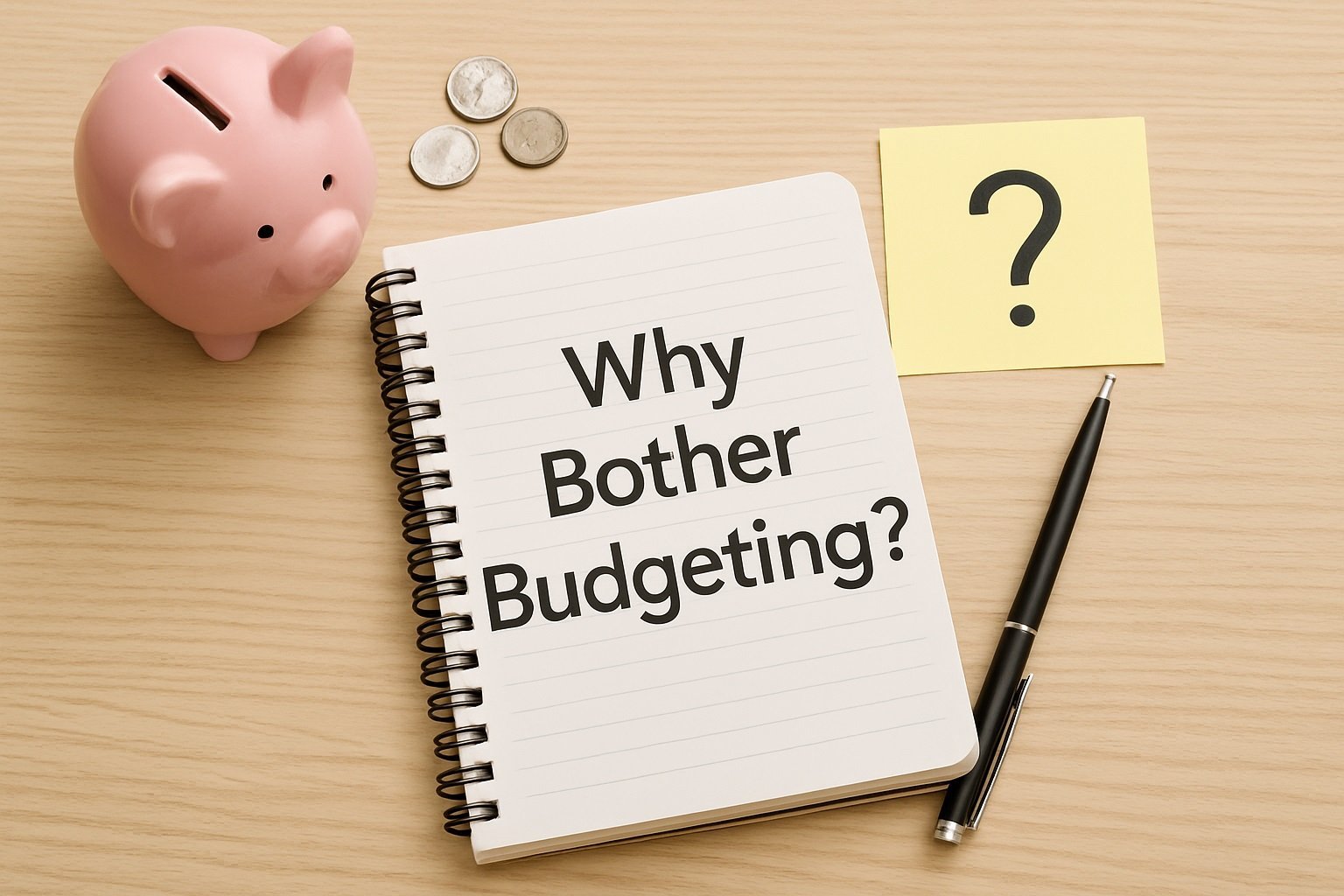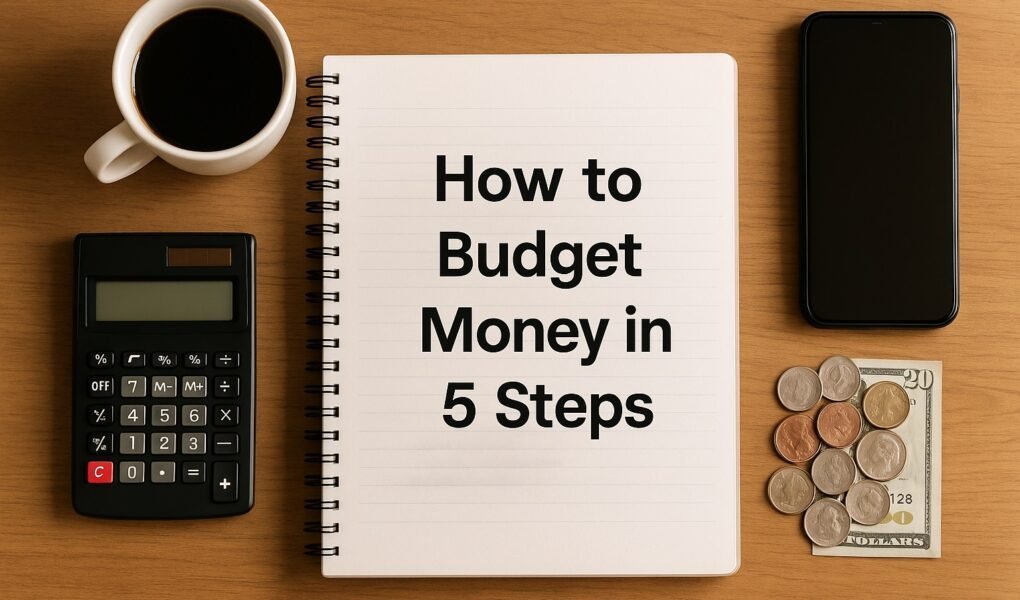A budget is nothing more (and nothing less) than a plan for every dollar you earn. Yet that simple roadmap has the power to turn the overwhelming stew of bills, apps and impulse buys into a clear story you control.
In the next few minutes you’ll walk through a five-step guide condensed from time-tested advice, the latest fintech tools and real-world success stories showing exactly how to budget money and keep your plan alive month after month. Think of this guide as a conversation with a money-savvy friend: plenty of context, zero judgement, and loads of budget tips you can try tonight.
You’ll see how to:
-
Pin down your true take-home pay even if you freelance or get paid in uneven bursts.
-
Choose a budgeting framework that matches your personality so you’ll actually stick with it.
-
Find and fix money leaks (looking at you, forgotten subscriptions).
-
Automate savings and debt pay-downs so willpower is out of the picture.
-
Review and refine your plan quickly because life, raises and emergencies happen.
Let’s get those dollars marching in the direction you choose.
Why Bother Budgeting?

Most of us already know budgeting is “good for you”, the way we know flossing or stretching is good for you. Here’s why it’s more than a financial chore and why these budget tips can change your stress levels and your bank balance almost immediately.
-
Money clarity replaces money fog. Without a plan, the question “Can I afford this?” gets answered by feelings, peer pressure or a wild guess. With a budget, you have a line item that answers for you.
-
Motivation multiplies. When you watch debt shrink or a Europe-trip fund grow, your brain releases a dopamine hit similar to finishing a workout. Small progress fuels bigger progress.
-
Emergencies stop becoming disasters. A busted tyre or last-minute plane ticket still stings, but it no longer knocks you backward because your plan included an emergency buffer.
-
Goals get dates, not just wishes. “Someday I’ll buy a home” becomes “I’ll have ₹6 lakh for a down payment by May 2027.” The specificity turns hope into a scheduled milestone.
-
Relationship friction drops. Couples who share a living, breathing budget report fewer money arguments because the spreadsheetor appbecomes the neutral third party. It’s not you saying, “We can’t afford brunch again”; it’s the plan you both agreed on.
-
Opportunity cost shrinks. When every rupee has a job, you’re less likely to let money sit idle in low-interest accounts or get sucked into mindless spending. Idle cash becomes invested cash; random purchases become strategic choices.
Budget tip: If you’ve tried budgeting and quit, odds are you picked a method that didn’t match your lifestyle. Keep readingSteps 2 and 3 show you how to custom-fit the process.
Step 1 – Know Your Real Take-Home Pay
Budgeting on gross income (the big number on your contract) is a highway to frustration. Instead, start with the cash that actually lands in your account after taxes, insurance premiums and retirement withholding. Here’s how.
What counts as net income?
-
Pay cheque after mandatory deductions. That means after income tax, Social Security, Medicare, professional tax or provident-fund contributions.
-
Add back voluntary pre-tax deductions you control. If 5% of your salary goes to an employer 401(k) or NPS automatically, decide whether to treat that as an expense (most people do) or as “already saved” and include it here. Just be consistent.
-
Monthly average of irregular payouts. Freelancers, sales pros and gig workers should total the last 12 months of deposits, divide by 12, and use that number. It smooths peaks and valleys.
-
Side-hustle or rental income after costs. Got a weekend photography gig? Subtract lens rentals, fuel and marketing costs first, then count the profit.
Budget tip: Use two bank accounts if you have freelance or side-hustle incomeone for incoming payments, one “paycheck” account. Twice a month, transfer a set amount (your average income) into the paycheck account. It turns jagged cash flow into a predictable salary.
Side gig or freelance? Build a “post-tax buffer”.
Irregular income makes budgeting tricky because tax isn’t withheld automatically. Protect yourself by:
-
Opening a tax-stash sub-account and sweeping 20–30% of every client payment into it on the day money hits.
-
Using last year’s lowest-income month as your baseline budget number. Any month you earn above that becomes bonus cash for debt pay-offs or a “future lean month” buffer.
-
Automating quarterly estimated-tax reminders on your phone so deadlines don’t destroy momentum (see Step 4 on automation).
By zooming in on what you truly keep, your five-step budget starts on solid ground.
Step 2 – Pick a Budgeting Framework
Frameworks are like workout styles – kettlebells, yoga, CrossFit – they all get you fit, but only if you enjoy and stick with them. Below are three popular frameworks plus a quick comparison grid to help you choose.
50/30/20 Rule in two minutes
-
Needs (50%). Housing, utilities, groceries, basic transport and minimum debt payments.
-
Wants (30%). Streaming subscriptions, dinner out, non-essential shopping, and hobbies.
-
Savings & debt repayment (20%). Emergency fund, retirement, extra loan principal.
Why it works: It’s simple, flexible and doesn’t require line-item micromanagement. Great for budgeting beginners who want a high-level guardrail instead of detailed categories.
Zero-Based vs. Envelope vs. App-First (YNAB, etc.)
-
Zero-Based Budgeting: Every rupee gets a job. If your income is ₹1 lakh, you assign the full ₹1 lakh across categories until nothing is unallocated, hence “zero” leftover. Pro: laser clarity. Con: time-heavy at first.
-
Envelope/Cash-Stuffing: A tactile version of zero-based budgeting – money goes into labelled envelopes (or digital “wallets”). Once an envelope is empty, spending stops. Pro: great for overspenders. Con: less convenient for online purchases.
-
App-First (like YNAB, Goodbudget, Mint’s successor): Apps connect live to your bank, auto-import transactions and nudge you when categories run low. Pro: automation + real-time visibility. Con: subscription fees in some cases.
| Framework | Best For | Effort Level | Tracking Style |
|---|---|---|---|
| 50/30/20 | New budgeters, busy families | Low | Monthly check-in |
| Zero-Based | Detail lovers, variable income | Medium-High | Daily/weekly |
| Envelope | Impulse spenders, cash lovers | Medium | Physical or digital “wallets” |
| App-First | Tech-savvy, on-the-go | Low-Medium | Real-time phone alerts |
Budget tip: Can’t pick? Run a one-month trial: Week 1 zero-based, Week 2 envelope, Week 3 50/30/20, Week 4 an app. Notice which feels naturalnot which seems “right.”
Step 3 – Track Spending & Spot Leaks
Even the sleekest framework collapses if the numbers feeding it are bogus. Tracking shines a flashlight on every rupee.
48-Hour Spend Diary Challenge
For two days, write down every spend the moment it happens. ₹60 chai, ₹450 app renewal, and ₹1 200 groceries. Use your phone notes or a pocket notebook.
-
Evening of Day 1: highlight purchases you forgot or felt guilty about.
-
Evening of Day 2: total non-essential spend. Multiplied over a month, these tiny hits often shock people into action.
Why 48 hours? It’s intense but short enough that you’ll follow through.
Subscription audit script
-
Pull the last 90 days of bank and card statements.
-
List recurring charges (music, cloud storage, apps).
-
Ask three questions: Do I use it weekly? Does a cheaper tier exist? Could I share a family plan?
-
Cancel or downgrade in the moment; don’t add to a “later” list.
Average yearly savings for this 30-minute audit: ₹8 000–₹25 000, depending on how many streaming wars you unknowingly fund.
Other tracking budget tips:
-
Set a ₹2 000 “speed bump”. Any purchase over that requires a 24-hour cooling-off.
-
Name your discretionary category. “Fun Money” feels better than “Miscellaneous”, making it easier to respect.
-
Colour-code spending in spreadsheets. green (needs), blue (wants), orange (savings/debt) – our brains love visuals.
Step 4 – Automate Savings & Debt Pay-downs
Willpower is overrated. Automation is the secret sauce that keeps your budget alive on your busiest, most distracted days.
Split-deposit pay cheque hack
Ask HR to send part of your pay cheque straight to savings or a high-yield account while the rest goes to checking. No transfer to forget, no temptation to “borrow” from savings.
Sample split for a ₹60,000 net pay cheque:
-
Checking (bills + spending): ₹45 000
-
High-yield savings (emergency fund): ₹7 500
-
Brokerage (index fund): ₹4,500
-
Loan payoff account: ₹3 000
Snowball vs. Avalanche: which motivates you?
-
Debt Snowball: Pay extra on the smallest balance first. Quick wins fuel momentum.
-
Debt Avalanche: Pay extra on the highest interest rate first. Mathematically cheaper.
Pick the one you’ll stick with. The difference in total interest is often smaller than the cost of quitting mid-plan.
Other automation budget tips:
-
Calendar-sync due dates so credit card autopay lands two days before the statement closes, reduces reported balance and may boost credit score.
-
Use round-up apps that skim change from purchases (₹98 becomes ₹100; ₹2 goes to savings). Over 12 months, those drips become a vacation fund.
-
Trigger “rule-based” transfers. Example: every time your checking balance exceeds ₹75 000 at month-end, sweep the surplus to investments.
Step 5 – Review, Refine, Repeat
Budgets aren’t concrete; they’re living documents that should evolve.
Quarterly budget check-up checklist
-
Income changes? Raise, side-gig surge or maternity leave.
-
Fixed costs shifted? Rent hike, insurance premium drop, new car payment.
-
Goal progress on track? Is the emergency fund at 3 months of expenses yet?
-
Satisfaction meter. Are you happy with how your budget balances needs, wants and the future?
-
Update targets. If you earn more, pre-decide where new cash goes (savings 50%, wants 30%, debt 20% is one example).
Time investment: 30 minutes quarterly. Reward: confidence all year.
When to upgrade your method
-
Overcomplicated? If you dread opening the spreadsheet, consider a simpler 50/30/20 overlay.
-
Under-granular? If you’re constantly surprise-overdrafting, shift to zero-based for sharper control.
-
Life milestone? Marriage, baby, relocation Introduce joint accounts or an envelope system as needed.
Budget tip: Book these reviews like dentist appointmentssend yourself a calendar invite for March 31, June 30, September 30 and December 31.
Common Roadblocks & Quick Fixes
-
Analysis paralysis. Problem: You read 20 blog posts and can’t start. Fix: Do a one-week “money snapshot track spend, choose any framework and refine later.
-
Partner resistance. Problem: One person is a spreadsheet nerd; the other lives in “tap card, hope it clears” mode. Fix: Hold a 20-minute “dream meeting”. Discuss goals (vacation, home, debt-free date) before numbers. Agree on one next action: combine groceries into a shared card or set a ₹5,000 pocket money limit each.
-
Lifestyle creep. Problem: Every raise evaporates into nicer wine and gadget upgrades. Fix: Adopt the Income-Increase Rule: At least 50% of every raise or bonus goes to savings or debt. Automate on day one so you never see the “extra” in checking.
-
Irregular expenses ambush. Problem: Car insurance renews yearly; Christmas gifts slam December. Fix: Create a “sinking fund” category, divide the annual cost by 12, and transfer that amount monthly.
-
Motivation drops after a slip-up. Problem: One big impulse purchase triggers a spending spiral. Fix: Institute a 48-hour pause, review your goals, forgive the blip and adjust next month’s wants category instead of abandoning the whole budget.
-
Tech overwhelm. Problem: Too many apps, too many pings. Fix: declutter to one primary budgeting tool and one banking app. Turn off non-critical notifications.
Remember: roadblocks are normal. The fix is rarely dramatic; it’s small course corrections layered consistently.
FAQ (People Also Ask)
What are the five basic steps of budgeting?
-
Calculate net income. Know what actually lands in your bank after taxes.
-
Choose a budgeting framework, e.g., 50/30/20 or zero-based, so your money has structure.
-
Track spending to verify reality matches the plan.
-
Automate savings and debt payments so habits run on autopilot.
-
Review and refine every quarter so your budget keeps fitting your life.
Consistently following these steps turns budgeting from a chore into a routine that protects and propels your finances.
What is the 50/30/20 rule?
It’s a quick-start guideline that divides net income into three buckets:
-
50% Needs: rent, utilities, groceries, insurance.
-
30% Wants: dining out, entertainment, and hobby gear.
-
20% Savings/Debt: emergency fund, retirement, extra loan payments.
While not perfect for every income level or cost-of-living area, it’s a powerful budget tip for beginners who need guardrails without micromanaging.
How do I stick to a budget every month?
-
Automate fixed bills and set them to autopay.
-
Use spending alerts, apps or SMS when you cross 80% of a category.
-
Schedule a weekly 15-minute check-in to look at upcoming bills and adjust categories.
-
Allow reasonable fun money so you don’t feel deprived.
-
Celebrate wins like clearing a credit card balance with a low-cost reward (movie night, picnic).
Your brain treats a budget like a habit trigger (alert), routine (adjust), and reward (progress). Build the loop consciously.
How can I budget on a variable income?
-
Base your plan on the lowest-earning month from last year.
-
Create a buffer account worth one month of expenses and fund it during higher-earning months.
-
Use percentage-based allocations (e.g., 30% taxes, 40% essentials, and 30% savings/debt) so the maths scales with income.
-
Delay non-essential spending until the end of the month when income totals are clear.
The goal is predictability, turning peaks into planned savings rather than feast-or-famine living.
Should I save or pay off debt first?
Do both, but sequence matters:
-
A starter emergency fund of ₹50 000–₹1 lakh (or $500–$1 000) to avoid new debt during surprises.
-
High-interest debt attack (credit cards, personal loans) using snowball or avalanche.
-
Simultaneously contribute enough to your employer retirement match – free money you don’t want to skip.
-
After toxic debt is gone, ramp up savings/investing percentages.
Think of savings and debt payoff as two pedals; you alternate pressure based on interest rates and risk tolerance.
How often should I update my budget?
-
Mini check-in: weekly 10-minute review, verify transactions, adjust categories.
-
Major review: quarterly 30-minute session to update income, goals, and cost changes.
-
Event-triggered review: job change, move, baby, marriage.
Regular tweaks keep the budget relevant, preventing “set-and-forget” from morphing into “set-and-regret”.
What if my partner hates budgeting?
-
Start with dreams, not numbers. Ask, “What would financial freedom look like for you?”
-
Use a shared fun fund. Each contributes a set amount; no questions are asked on how it’s spent.
-
Keep the first joint meeting short (under 30 minutes) and celebrate one agreed-upon action (like setting a grocery limit).
-
Assign roles based on strengths. Spreadsheet lover handles data; big-picture thinker monitors goal progress.

